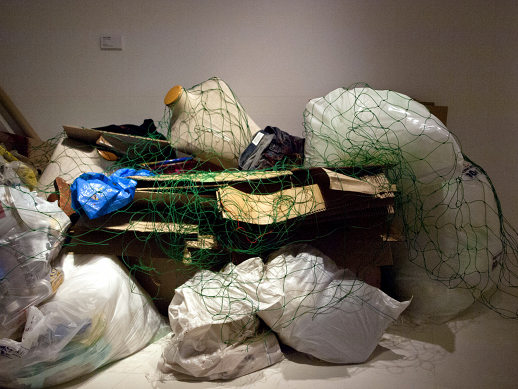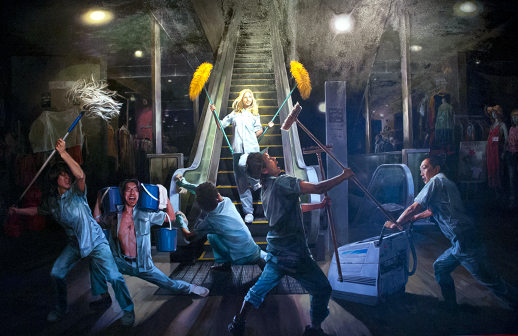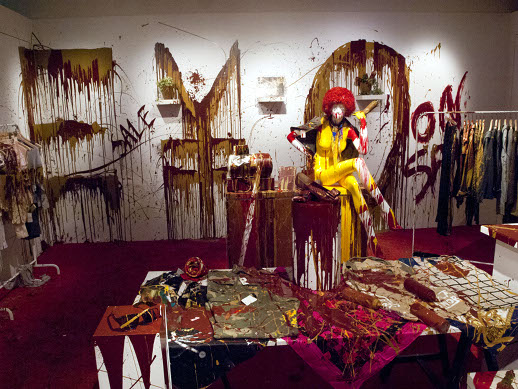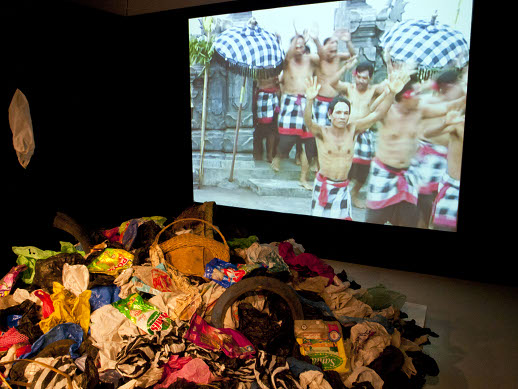Trashy Art or Artsy Trash?
In the Fifties, Kazuo Shiraga was famous for painting images with his feet until they resembled multi-colored Rorschach tests. Back then people might have assumed he was crazy but he was not just playing around. He was a member of the Gutai, an artist collective started in post-World War II Japan and whose art was always created with the requirement that it be original.
In the late Eighties the crack epidemic hit New York City. Poor African American and Latino kids escaped from their project housing and into subway tunnels, where they spray-painted their names on trains to “catch fame”, to prove to the affluent that they existed. Artists like Rammellzee, Futura and Dondi were painting trains not knowing their impact on the world.
And now, framed within the contexts of the Internet, short attention spans, and the post-earthquake-tsunami era in Japan, the Tokyo-based art collective Chim Pom have broken into the local consciousness as would-be rebels.

An interesting parallel can be drawn between Banksy and Chim Pom: One makes street art; the other, inspired by Princess Diana, took a Louis Vuitton bag and an iPod to Cambodia to blow up with a landmine, auction off the remains and donate the proceeds to charity. One put a florescent orange blow-up doll in handcuffs and placed it in a Disney World attraction, a nod to the US torturing accused terrorists. The other was inspired to do performance art after watching the movie Jack Ass. One is the most famous artist in history to never be identified. The other captured rats around Shibuya and turned them into recycled icons after stuffing them and calling them “super rats”.
In a new exhibition in Shibuya at the Parco Museum, the hipster pranksters Chim Pom are at it again. On the opening day of their largest scale show to date, they filled a two-story trash bag with human beings in front of the museum. Their art installations fill three rooms, but the first thing you will actually see is a painting in the lobby, ‘Cleaning’ (from the series “Capitalist Realism Painting”), depicting all six members as janitors celebrating what will soon be a trashed mall.

Enter the first room, a woman’s clothing department, trashed. Brown, yellow and red paint splattered: on the walls, clothes, floor, mannequins, scarfs, cash register etc. McDonald’s is getting a free plug from Chim Pom because their ketchup pack is sitting next to a Ronald McDonald-like mannequin holding a squeeze bottle. And yet, if they are anti-capitalists, it is difficult to appreciate when their show is on the fourth floor of a shopping mall.
The second room is filled with nothing but “CP” (stolen from the Parco logo on the outside of the building) in big neon lights blinking in sync with an epic score, a true rock star’s companion. The sign was inspired by the museum’s own logo. The last room is two piles of trash (literally) and three videos of the six-member crew doing what they became famous for–stunts: Dumping trash from a helicopter, spray-painting nuclear waste signs on trash bags and filling empty ones with carbon monoxide from their motor scooters. The latter, in case you can’t imagine, is so the carbon monoxide bags pop in the face of garbage men.

The last exhibit is a series of crude pen drawings of their ideas for the show. On your way out (to McDonald’s) you can purchase one of their authentic “We are Super Rat” t-shirts or a book that explains their work. If that’s too much for your wallet, you can get a postcard of Ellie, the only female of the group, posing with a stuffed crow.
Shock tactics are still a new concept to Japan and these pranksters have taken full advantage of this fact. What makes Chim Pom relevant to Japan’s modern art scene is that they have managed to frame a context around their stunts that instigates conversation and attention, not to mention controversial Japanese artist, Makoto Aida, co-signed for them. Chim Pom’s current exhibition may leave you frustrated after spending 500 yen to see trash. They are hustlers, turning Japan’s 3.11 earthquake and tsunami tragedy into an exaggerated piggy bank. They’re also a performance art group, disguised as an art collective, but who cares about the difference if you are really just indirectly auditioning for Johnny Knoxville from Jack Ass.

When interviewed by PBS’s Frontline, the group’s leader, Ryuta Ushiro, said that he wanted to produce work in the wake of 3.11 that would echo through time to future artists. Is it conceivable that history will catalogue a group of kids trashing rooms and calling it art? The Gutai could well have been the Chim Pom of their day. But when Kazuo Shiraga was painting with his feet in front of an audience, perhaps he was embracing humility to encourage inclusion. His goal was to give voice to a post-war generation – as opposed to just trying to become famous.
Tracy Jones
Tracy Jones



